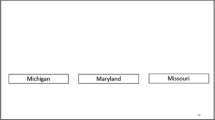Abstract
Much of the comparative research on stimulus overselectivity has been flawed by either failure to control for chronological age and language ability of the subjects or reliance on the controversial technique of matching on mental age. The present study investigated the prevalence of overselectivity in autistic, trainable mentally retarded, and non-handicapped children demonstrating some expressive speech. The ages of the children were between 6 years-6 months and 9 years-3 months. Thus, chronological age and language ability were controlled, rather than allowed to vary unsystematically. Results indicated no significant differences between the autistic and TMR samples, but significant differences between the handicapped samples and the non-handicapped group. Some, but not all, of the handicapped children displayed overselectivity.
Similar content being viewed by others
Reference notes
Frankel, F. Stimulus selectivity in autistic, retarded, and normal children. Paper presented to Canadian Society for Autistic Children, Vancouver, B.C.; May, 1978.
Tinley Park Mental Health Center.Tinley Park language assessment. Chicago, Illinois: Author. Undated.
References
Bailey, S. Stimulus overselectivity in learning disabled children.Journal of Applied Behavior Analysis, 1981,14, 239–248.
Baumeister, A. A. Problems in comparative research.American Journal Mental Deficiency, 1967,71, 869–875.
Campbell, D., & Stanley, J.Experimental and quasi-experimental designs for research. Chicago: Rand McNally, 1966.
Eimas, P. D. Multiple-cue discrimination learning in children.Psychological Record, 1969,19, 417–424.
Gellerman, L. W. Chance order of alternating stimuli in visual discrimination experiments.Journal of Genetic Psychology, 1933,42, 206–208.
Gersten, R. The search for the cognitive deficit in autism: Beyond the stimulus overselectivity model.The Journal of Special Education, 1980,14, 47–65.
Irvin, L., Gersten, R., Bellamy, G. T., Taylor, V., & Close, D. The trainee performance sample: Improving vocational skill assessment for the severely retarded.American Journal of Mental Deficiency, 1981,85, 631–638.
Keppel, G.Design and analysis: A researcher's handbook. Englewood Cliffs, New Jersey: Prentice-Hall, 1973.
Kerlinger, F.Foundations of behavioral research (2nd ed.). New York: Holt-Rinehart, 1973.
Koegel, R., & Lovaas, O. Comments on autism and stimulus overselectivity.Journal of Abnormal Psychology, 1978,87, 563–565.
Koegel, R., Dunlap, G., Richman, G., & Dyer, K. The use of specific orienting cues for teaching discrimination tasks.Analysis and Intervention in Developmental Disabilities, 1981,1, 187–198.
Koegel, R., & Wilhelm, H. Selective responding to the components of multiple visual cues.Journal of Experimental Child Psychology, 1973,15, 442–453.
Kovattana, P., & Kraemer, H. Response to multiple visual cues of color, size, and form by autistic children.Journal of Autism and Childhood Schizophrenia, 1974,4, 251–261.
Litrownik, A., McInnis, E., Wetzel-Pritchard, A., & Filipelli, D. Restricted stimulus control and inferred attentional deficits in autistic and retarded children.Journal of Abnormal Psychology, 1978,87, 554–562.
Lovaas, O. I.The autistic child-Language development through behavior modification. New York: John Wiley, 1977.
Lovaas, O. I., Koegel, R. L., & Schreibman, L. Stimulus overselectivity in autism' A review of research.Psychological Bulletin, 1979,86, 1236–1254.
Lovaas, O. I., Schreibman, L., Koegel, R., & Rehm, R. Selective responding by autistic children to multiple sensory input.Journal of Abnormal Psychology, 1971,77, 211–222.
Ritvo, E., & Freeman, B. National Society for Autistic Children definition of the syndrome of autism.Journal of Autism and Childhood Schizophrenia, 1978,8, 162–167.
Schaeffer, B. Spontaneous language through signed speech. In R. L. Schiefelbusch (Ed.),Nonspeech language and communication: Analysis and intervention. Baltimore: University Park Press, 1980.
Schover, L. R., & Newsom, C. D. Overselectivity, developmental level, and overtraining in autistic and normal children.Journal of Abnormal Child Psychology, 1976,4, 289–298.
Schreibman, L. Effects of within-stimulus and extra-stimulus prompting on discrimination learning in autistic children.Journal of Applied Behavior Analysis, 1975,8, 91–112.
Silvertsen, B. Overselectivity, mental age and behavioral development: A comparison of normal and autistic children. (Doctoral dissertation. University of California, Los Angeles, 1976).Dissertation Abstracts International, 1976,37, 2562B. (University Microfilm No. 76-25, 242.)
Wilhelm, H., & Lovaas, O. I. Stimulus overselectivity: A common feature in autism and mental retardation.American Journal of Mental Deficiency, 1976,81, 227–241.
White, O., Edgar, E., & Haring. N.Uniform performance assessment system. College of Education, Experimental Education Unit, Child Development and Mental Retardation Center, University of Washington, Seattle, 1978.
Winer, B. J.Statistical principles in experimental design. New York: McGraw-Hill, 1971.
Wolfe, V. F., & Cuvo, A. J. Effects of within-stimulus and extra-stimulus prompting on letter discrimination by mentally retarded persons.American Journal of Mental Deficiency, 1978,3, 297–303.
Author information
Authors and Affiliations
Additional information
This paper is based on a doctoral dissertation completed at the University of Oregon. Benson Schaeffer, Lewis Goldberg, and Barbara Bateman offered invaluable assistance throughout all phases of the project. The author wishes to thank Stan Paine, Harriet Kandelman, and especially Doug Carnine and Bill White for careful critical readings of earlier drafts. Edna Kleinman and Adrienne Gersten of the National Society for Autistic Children were extremely helpful and supportive in the day-to-day logistics of the study. Most especially the author wishes to express his appreciation to Mike Manfra, Larry McLeod, Steve Miliaras, Dale Petell, Stephen Reilly, Fred Harvey, Geoffrey Frank, and John Fricke for the invaluable insights they provided on issues in learning and language development of children with severe communication disabilities.
Rights and permissions
About this article
Cite this article
Gersten, R. Stimulus overselectivity in autistic, trainable mentally retarded, and non-handicapped children: Comparative research controlling chronological (rather than mental) age. J Abnorm Child Psychol 11, 61–75 (1983). https://doi.org/10.1007/BF00912178
Revised:
Issue Date:
DOI: https://doi.org/10.1007/BF00912178




